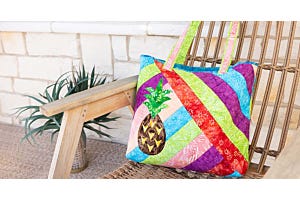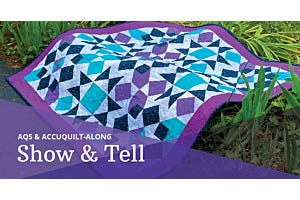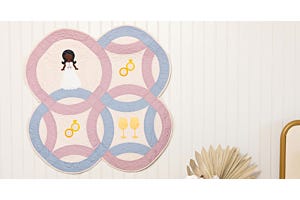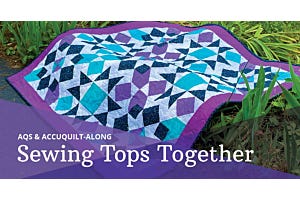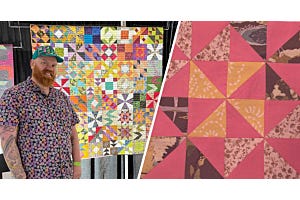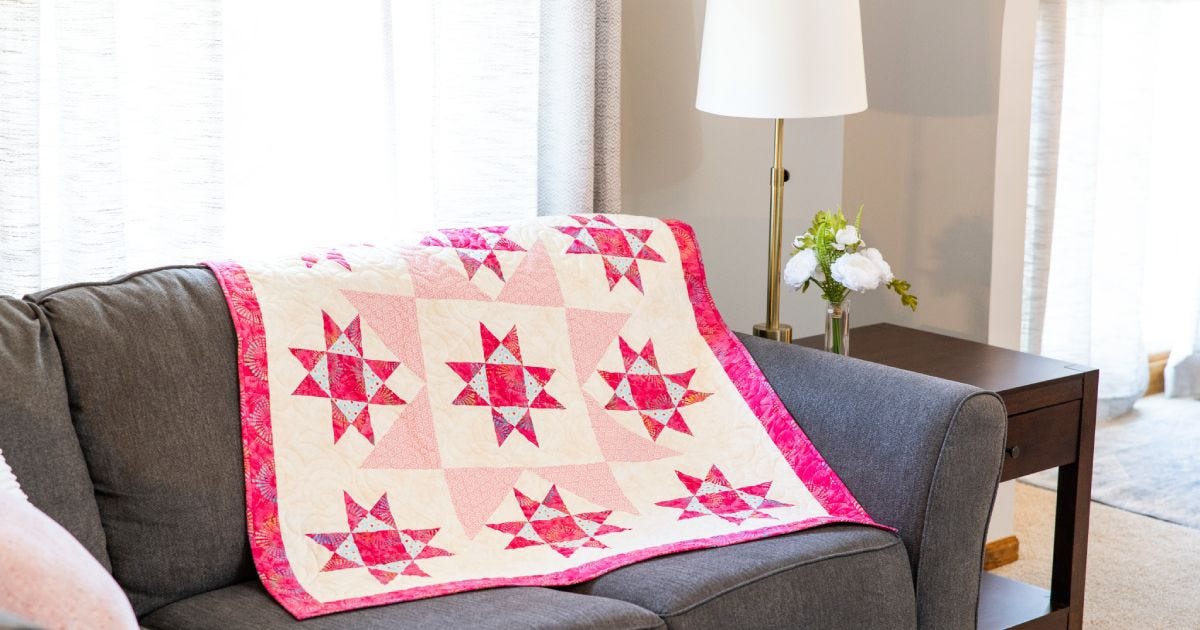
Welcome to Part 4 of the AQS & AccuQuilt-Along Series, where we're making the GO! Stars in the Crown Throw Quilt. This is the first of five fun quilt-along series events we’ll be co-hosting in 2023. If you’re just joining us, no worries! Feel free to go back to the introduction blog post on February 1 to get started. You can also watch our past livestream shows making this project on our website, Facebook page and YouTube channel. Here’s last week’s show:
I can’t believe that this week, we’re finishing off our tops with borders and talking about quilting and binding. It’s been great seeing everyone’s creations along the way on the AQS Quilting Project Parade Facebook Group as well. If you haven’t joined that group yet, be sure you do.
Let’s GO!
Last week, we finished putting the center of the top together and really saw our quilts start coming to life! You’ll want to be sure and give this center a good press before adding your borders.


Now, let’s cut those border strips! I’m using my GO! Mix & Match 8” Block, which will be the same size as the rotary cutting directions for this project. If you’re using a different size GO! Qube, be sure to refer to your pattern for the size of your borders and cutting directions, but now’s a fun time to personalize your quilt a little, too.
We’ve seen wonderful pictures posted on social media of all your projects, and seeing all the personal touches being added, like wider borders, double borders and more. Don’t hesitate to change things up and make your own creative choices here, but I’m going to be following the pattern here.

My pattern calls for cutting 2 1/2” strips for the border - four of them - and as we know, there’s a die for that! I’ll be using my GO! Strip Cutter-2 1/2” (2” Finished) 3 Strips Die for this step. The die cuts three strips across, so I’m going to cut an 11” x Width of Fabric (WOF) strip, and cut off the selvedge edges.
Now, I can lay my fabric across the three strips on the die, and fanfold back over the first strip. This will give you all four strips in one pass through the cutter.
If you have a GO! Me Fabric Cutter, you can still die cut your strips with the GO! Strip Cutter-2 1/2” (2” Finished) Die that cuts two strips across instead of three, meaning it’s a 6” x 24” die.
Measure Twice…
While the pattern and rotary directions include the length of each border strip, you’ll want to be sure and measure both the length and width of your project before you cut your WOF strips down. In fact, I suggest that you measure the length of the quilt on each end and the middle to be sure that your project is “square.”
Once the side borders are on, press the seams towards the border, and then measure the width. This way, you can rest assured you’ll have perfect borders! Press those seams and do a happy dance because your top is complete!
What’s Next?
There are so many options when it comes to quilting, but before you even get there, you’ll need batting and backing. Here, you’ll find so many options to consider that you may again find yourself frozen with decisions to make, but don’t worry!
Batting comes in many materials, such as cotton, an 80/20 cotton blend, polyester, bamboo, wool and more. I would guess that the majority of quilters prefer either 100% cotton or the 80/20 blend. I lean towards the blend.
Batting also comes in natural, creamy color or white. If you have a lot of white in your quilt, I suggest going with a white batting, so your whites don’t take on an off-white or creamy yellow tint once quilted.
Backing has options as well, and I freely admit that in my early quilting days, picking backing was a problem for me! Depending on the size of your project, it can be a rather large piece of fabric. Frankly, I had commitment issues! I’ve gotten much better over time, but here are some options to consider:
- Selecting one fabric to use and piecing as needed to make it wide enough (be sure to use 1/2” seams here!)
- Using an extra wide fabric
- Using scraps or a variety of fabrics to piece your back
- Using a different fabric type, like flannel or Cuddle
With larger quilts, I really like the ease of using extra wide fabric, and for lap quilts, I like Cuddle – it gets cold in Nebraska!
The single item that has helped me the most is an extra large top for my ironing board. Little did I know how much this would help me or I would have done this years ago!
Quilting
Okay, now we can finally talk about quilting! Once again, there are choices to be made:
- Quilt yourself on a domestic or longarm machine
- Have it quilted by a longarm quilter
This leads us to deciding on style and/or design! There are almost too many options to list, but in today’s show, Pam and I stuck to the basics with stitch in the ditch and echo quilting. Stitch in the ditch is stitching right along the seam line. This is a great time for a walking foot - if you have one!
Echo quilting is following the designs in the quilt away from the seams. You might think of this as “away from the ditch.”
You might also want to consider straight line quilting or even free motion quilting, which has endless possibilities. This is where your originality can really shine through!
Binding Time!
You know what’s coming, right? You have options here as well! The pattern calls for cutting your binding strips at 2 1/2” wide, which is my typical binding size. Some quilters prefer to use a 2 1/4” strip, but both will work the same.
I’m considering using a flange binding on my quilt. This technique gives a faux piping look to the edge of your quilt with just a hint of a second fabric. Here's a recent AccuQuilt Live with Pam showing different binding techniques:
Just like that, your quilt is finished and ready to share with all of us! Next week, we'll be wrapping up this quilt-along series with a show and tell episode, where we'll share our projects with you and lots of the great project pictures you've all be posting! I have to say that this project has really been fun, but getting to interact with all of you has been even better!
Be sure to keep posting pictures of your progress on the AQS Quilting Project Parade Facebook group page and other social media platforms using the hashtag #AQSews in your description.
See you next week!


